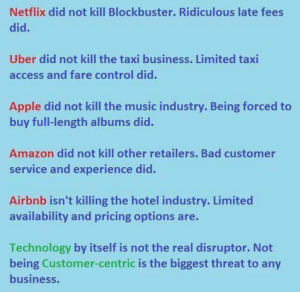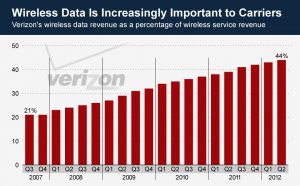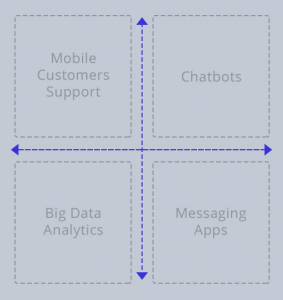I was giving a talk earlier this month in which I mentioned that technology is an enabler not a disruptor of business today.
It was to the BPW Lake-Geneva (Business & Professional Women) group in Rolle, Switzerland, which was a first for me. Not because I was speaking about customer centricity as a disruptor, but because it was an all-female group. (They even turned away one gentleman who was interested in hearing me speak about adopting a customer-first strategy!)
Anyway, my talk was about identifying the category in which you are working, the benefit you provide and the audience to whom you are offering it. These are the first three steps of my CatSight™ Process for actionable insight development. (If you would like to know more about our online and offline training offers, please let me know)
During the presentation at BPW I talked about the fact that technology is seen as the disruptor in business today, but it isn’t. Technology is an enabler; it’s customer-centricity that is the disruptor today.

Source: Marco Pacheco
Executive Director JP Morgan
It was
I had already been speaking about the need for businesses to prepare for the dramatic change that was coming thanks to technological innovation. However, Pacheco’s slide made me realise why I was so keen on companies adopting a customer-first strategy and running scenario planning.
His five simple examples brought it home more powerfully than I have ever done before. That’s why I wanted to share it. The summary says:
- Netflix did not kill Blockbuster, ridiculous late fees did.
- Uber did not kill the taxi business, limited taxi access and fare control did.
- Apple did not kill the music industry, being forced to buy full-length albums did.
- Amazon did not kill other retailers, bad customer service did.
- Airbnb isn’t killing the hotel industry, limited availability and pricing options are.
In conclusion it states that:
“Technology by itself is not the real disruptor. Not being customer-centric is the biggest threat to any business.”
That’s music to my ears!
Looking again at the five examples he gives, there are a number of specific aspects of customer-centricity that are highlighted. In my opinion they show the following advantages for the customer:
- freedom of choice
- transparency
- trust
- being valued.
If you don’t want to see your own industry fall victim to start-ups that better provide these, then now is the time to act. Include all these essential elements into your own business. In my opinion they should already be there and industries where they are not, are already being threatened. Make sure you’re not on the new list next year!
The Future of Many Industries is Unthinkable
As I mentioned at the beginning, technology is an enabler that permits industries to provide more of what their customers want. There are already many examples of ones which have been helped or radically altered by technology and science. For example:
 Telecoms now make as much money from selling (geo-localisation) data than they ever did from selling phones and lines.
Telecoms now make as much money from selling (geo-localisation) data than they ever did from selling phones and lines.
Already in 2015 data accounted for 44% of Verizon’s profits, as shown in this Adage article.
Don’t you think their business model has changed – dramatically? Are they happy they made the change? You bet; it is growing faster and more profitably than ever before!
- Food companies are shifting from machine-made to do-it-yourself meal-kits. In fact, to be precise, the industry is being ever-more disrupted by start-ups offering replacements to the mass-produced, less-than-healthy products that Nestle, Mondelez, Kraft Heinz and Danone have been used to churning out.
Companies like Blue Apron, Green Chef, HelloFresh, Martha & Marley Spoon, Plated, and Sun Basket are offering healthier and fresher alternatives.
The largest food manufacturers are trying to compete by lowering “bad” ingredients and increasing “good” ingredients in their mass-produced brands. However, take a look at what they are doing in detail and you will see that in most cases their “improved” products are not better for us. They still have far too much sugar, salt and trans fats, despite being reduced. They still lack fresh ingredients, which we all know are far better for nourishing a live body.
- Beverage manufacturers are getting into entertainment in a big way. They have always sponsored or promoted events, bars and cafes. Coca-Cola is probably the best known for this with sponsorships including American Idol, Apple iTunes, BET Network, NASCAR, NBA, NCAA, and the Olympic Games.
But some drinks manufacturers are going much further and have now started including media development too. As a great example, think about Red Bull which today is seen more as an entertainment company that just happens to make a drink!
- Tobacco and cigarette manufacturers have been fighting to protect, even save, their industry for decades. Andre Calantzopoulos, CEO of Philip Morris International, recently declared in a Radio 4 interview that
“I believe there will come a moment in time where I would say we have sufficient adoption of these alternative products … to start envisaging, together with governments, a phase-out period for cigarettes.”
Coming from one of the largest global cigarette manufacturers, this is huge! But he is (hopefully) right. The future of the tobacco business is in heating rather than burning it, at least short term. Longer term I believe they need to look to other ways of providing personal pleasure that does less harm to the user and to their environment.
- Pharmaceuticals have for years been moving investment from sickness to wellness and health. An excellent article on the topic mentions that
“The transition from current ‘high-risk, high-margin’ business model to ‘low cost high volume’ nutria business model is dependent on many factors and also advised to move into less regulated markets like animal and consumer health.”
The line between Food and Pharma is blurring as companies expand and invest in the “other side” of nutraceuticals.
The line between Food & Pharma is blurring as companies expand & invest into nutraceuticals. Click To Tweet
Which will win out in the long run? Your guess is as good as mine, but I’d love to hear your thoughts in the comments below.
- Transport. Will there even be a viable automobile business in the future? How many manufacturers will survive as the market for personalised road transport collapses?
As people move from ownership to rental, and from self-drive to driven, the industry will need to move into alternative modes of transport to make up the shortfall in their businesses. What do you think?
Harnessing technology to enable companies to adopt a customer-first strategy
A 2016 Forrester report shows that while 72% of businesses say improving customer experience is their top priority, only 63% of marketers prioritize implementing technology investments that will help them reach this goal!
It therefore makes sense that I include in this post some of the best examples I have found to start you thinking about your own situation.
How are you harnessing technology to provide your customers with greater freedom of choice, trust, transparency and the demonstration that you value their business and loyalty? Here are some inspiring examples and ideas:
- Amazon uses technology to identify suggested products to their clients. Many others have followed this great example and we are now bombarded with “people like you also bought…” proposals. Like it or loath it, they do come in useful occasionally, don’t they? It also shows that the company is using your data for your good and not theirs (alone).
- Your websites can provide your customers with a wealth of information. It can also provide a platform for them to share their tips, ideas and associated facts which would be useful to other users, as well as ask questions. Petcare, Personal Care and Homecare brands make use of this in particular. Check out P&G and Mars Petcare for a couple of the best.
- Insight development today uses more than information from market research. Therefore technology is used to enable quicker and deeper integration and analysis of all the information flowing into an organisation. Machine learning adds further value by understanding the relationships between the data which may have previously gone unnoticed. Many of the global CPG companies are going this, including Unilever and Coca-Cola.
- Social Media has become the new customer services department because replies are almost instantaneous. Pizza Hut is a great example of this, answering any customer complaints in record time. Other brands react more slowly and then feel the wrath of their customers who are today expecting immediate answers to their questions. Make sure that’s what you offer!
- Chatbots are providing additional resources to the already overworked customer services departments. Findings from recent research in the UK show that many high street brands offering live chat and chatbot technology consistently performed better in customer sentiment analysis.
These are all examples of ways that are already being used so you can benefit from the experiences of others. But the world is moving fast and you need to also be exploring further new territories where technology can help.
Earlier this year ZDNet highlighted five technologies that touched on technological changes that could impact customer service and experience by the year 2021. They were:
1. Two-way video

2. Augmented and virtual reality
3. Virtual assistants
4. Messaging
5. Connected devices
As you can see, all five technologies are enablers of improved customer satisfaction, which will lead to increased relationship building and trust. Customers view them as novel and useful today, but it won’t be too long before they are seen as the norm. Are you using them? If so, what experiences have you had, as I’d love to hear more about their uses?
Another recent article, this time on Jacada, spoke about the “4 Technology Trends set to Improve Customer Experience in 2017.” (See their diagram on the right) In it they highlighted ChatBots, Big Data analytics, Mobile customer support and messaging Apps.
In this article they pulled out the larger areas around how technology can help with mass connection and analysis of the resulting exchanges.
What both these articles highlight is the need for marketing to harness technology in order to build relationships with their customers. If they do so, they can set their brands apart from the competition. If you are not already doing so, then you have little time remaining to catch up before being left seriously behind.
It conclusion, it is clear that technology can and should be employed to improve the customer’s experience. We live in a fast-paced world where we expect instantaneous responses from brands, and information at our fingertips where and when we need it. Technology is the only way we can meet these increased customer demands, by collecting, analysing and then actioning the learnings from these contacts.
Which of these are you working with today? I’d love you to share your experiences – good and bad – below.




I love this point of view. In the age of digital disruptors the failings of the prevailing business models are over looked, the shift to a consumer focused ‘What I want, in the format I want, through the channel I want, & when I want’ is what’s enabled these organisations to succeed.
That said though I am concerned by some of the negative business models behind some of the disruptors, where funding is being used to effectively destroy existing industries. I’d prefer to see competition on merits.
Thanks for your comment Robert.
I never thought about these businesses having negative business models, but I suppose you are refrring to Uber? If not please correct me.
I still think the idea of just in time transport is the future and whether it is through this model or car rental or flying taxis, I think personal transport ill see big changes. And my expectation is that the most customer-centric of them will win in the long term.
Thanks again for your comment.
I was thinking of Uber, but you could also look to Amazon and how the funding behind them enabled them to practically wipe out bookstores.
That said the arrival of Uber in Australia has lead to the local taxi firms being more innovative and producing Uber-esque apps to help with booking & journey planning. The issue remains though about level regulatory playing fields.
One thing that has (pleasantly) surprised me is how some of the older industries are leading the way in digital innovation such as mining & the automobile industry with connected vehicles.
Interesting to hear the differences between the West and Australia.
As a customer champion, I believe it is deeper customer understanding that brings the success. Whether a company makes good or bad choices in how they do it is a separate issue. I don’t know about Amazon’s funding, but they still care about their customers – which is about everyone of us reading this!